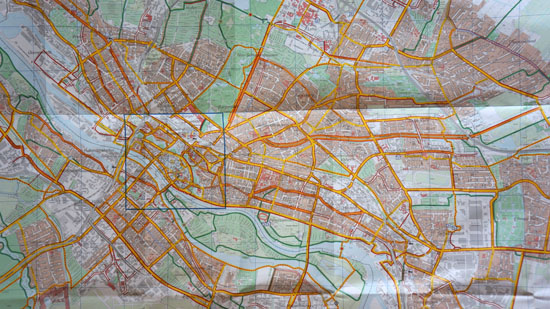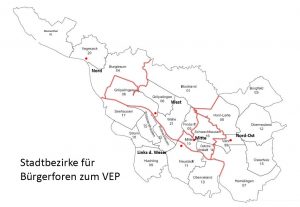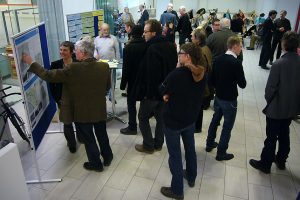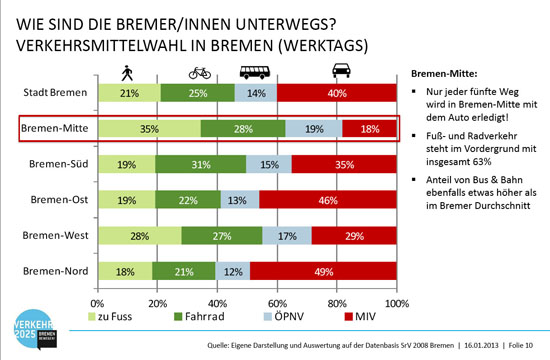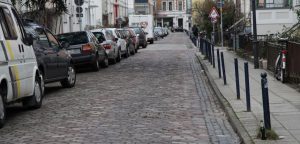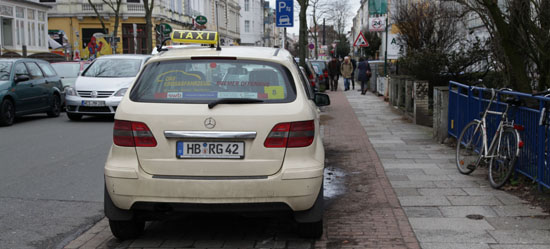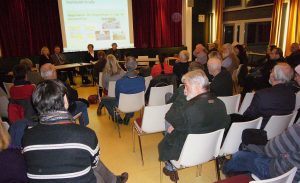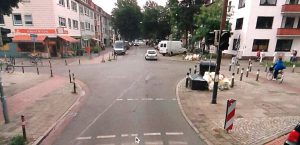 The tour itself took in a series of examples of infrastructure that explained the historical and cultural stories behind Bremen’s remarkable status as the German cycling city – one of the first cycle paths (early 1900’s) along Am Wall; the rather tired and ageing cycle paths of the 1920’s that are suffering from tree roots, the site of the great battle of the 1970’s, Mozartstrasse, that stopped the building of an urban motorway through a residential district and helped transform the city’s transport policy; the resultant calming of the area through a series of one-way streets for motor traffic, all passable two-way for cyclists; the provision of decent-quality cycle paths along all major routes; and some of the most recent developments, such as a new protected cycle lane on Herdentor, created through the conversion of a full-width traffic lane.
The tour itself took in a series of examples of infrastructure that explained the historical and cultural stories behind Bremen’s remarkable status as the German cycling city – one of the first cycle paths (early 1900’s) along Am Wall; the rather tired and ageing cycle paths of the 1920’s that are suffering from tree roots, the site of the great battle of the 1970’s, Mozartstrasse, that stopped the building of an urban motorway through a residential district and helped transform the city’s transport policy; the resultant calming of the area through a series of one-way streets for motor traffic, all passable two-way for cyclists; the provision of decent-quality cycle paths along all major routes; and some of the most recent developments, such as a new protected cycle lane on Herdentor, created through the conversion of a full-width traffic lane.
Throughout the three-hour tour, we were followed by a very friendly camera crew from Radio Bremen, who wanted to produce a short piece for that evening’s local news transmission. Now we were so caught up in preparing the content of the tour – you know the stuff, history, culture, technical standards of infrastructure and so on – that we quite overlooked the media take on what we were doing, and how it might be redacted by our nice TV crew. Radio Bremen, along with the wider trend in broadcast television, is increasingly interested in populist angles, amusing titbits that make the audience smile, but might not impart much knowledge about the subject in question. But sometimes it works.
Let’s have a bit of fun ourselves, shall we, and consider the piece that went out last night her in Bremen:
Viewers who understand German will have already taken in much of what is to follow, but for the rest here is a brief explanation.
The opening intro describes Cambridge as the city with the highest number of Nobel Prize winners in the world. But here comes a delegation from the city who want to learn something from us, ie German cycling culture. We cut to the first shot from the report – of James, the most eccentric-looking (ie typical English prof type) of the delegation (as it happens I would add one of the most intelligent and thoughtful). Cue Elgar music and the first voice over “This here is for many, many Bremer the worst of all – a bicycle journey around the Stern roundabout….But for the lobby group from Cambridge, it’s a paradise”.
James explains to camera why it is good (the cross-hatching separating cyclists from traffic), and that it’s something worth trying in the UK. First statement of disbelief from the reporter, given that this roundabout is an accident hotspot. But bear in mind, the whole point of introducing the cross-hatching, which was added just 3 years ago, is to try to reduce these accidents. We filmed previous visitors (from Newcastle Cycling Campaign) to this roundabout last year:
On to another scene, and another Cambridge campaigner, Martin, marvels at the quality of Bremen cycling infrastructure. Second statement of disbelief from the reporter. “Strange, we Bremer are not so enthusiastic. The cycle paths are too narrow, and haven’t been improved enough”. The dearth of cycling infrastructure in England is then explained.
We then cut to a shot of a row of parked kids bikes, probably outside a kindergarten. We explain how good infrastructure means freedom for kids on bikes, even at the age of 4. And for German viewers, it is explained that young kids “don’t cycle”. Not strictly true, of course, they “play” on their (normally stabiliser-equipped) bikes, but don’t go to nursery on them.
The piece ends with a funny quip about one universal characteristic of cyclists everywhere – their hatred of car drivers. We return to James, who declares that “pedestrians deserve the best surface, cyclists the second best, and motorised vehicles the worst. Motorists don’t need a flat surface.” Even so, the reporter is happy that visitors to Bremen have come, seen, and enthused about cycling in the city.
Did it work? I suspect the piece made Bremen viewers smile at the stereotypical English James. And in between the smiles, perhaps it was helpful to remind people that they’ve got, by international standards, a good quality network of cycling infrastructure. Even we can get too caught up in the internal debates around the Bremen Traffic Development Plan, and forget the solid grounding that underlies much of what is done in Bremen.
What we don’t see in this particular edit is the scene right at the beginning of our tour, when we are showing the map of Bremen cycling infrastructure to our visitors, and the looks of disbelief on their faces.
As we explained, every red line on this map represents a cycle path. And every busy, main road has a cycle path alongside it. This is something that campaigners in the UK can only dream of. Yet it is now built into the DNA of Bremen (though not all German) traffic planners. Busy main roads must provide for good quality, safe and attractive cycling infrastructure. This is what makes Bremen a cycling city. This is what the Cambridge visitors really appreciated.


